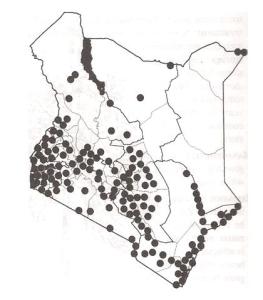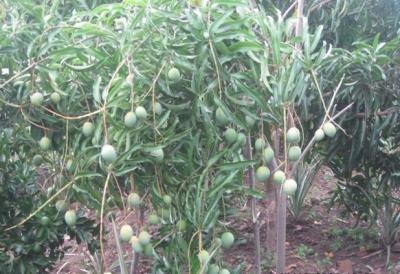Introduction
General Distribution:
 |
| Distribution of Mangifera Indica in Kenya |
| © Maundu P. and Bo Tengnas. (2005). Useful trees and shrubs for Kenya, World Agroforestry Centre. |
 |
| Mango fruit |
| © Bo Tengnas |
General Information about the Tree:
Biophysical Limits:
Mean annual temperature: 19 - 350C,
Mean annual rainfall: 300 - 2500 mm
Soil type: Mango trees thrive in well-drained soils with pH ranging from 5.5 to 7.5 and are fairly tolerant of alkalinity. For good growth, they need a deep soil to accommodate the extensive root system.
Propagation and Tree Management
Products:
- Food: Mango is cultivated for the fruit, which can be eaten in 3 distinct ways: unripe, ripe (the common way to enjoy mango throughout the world), and processed (at various stages of maturity, in the form of pickles or chutneys, dried slices, canned slices in syrup, juice and puree or paste).
- Fodder: Mango leaves are occasionally fed to cattle, but it should not be in large quantities as it can cause death.
- Apiculture: M. indica is an important honey plant, secreting large quantities of nectar.
- Fuel: its wood makes excellent charcoal and firewood.
- Timber: Its wood is used for many purposes, including indoor construction, meat-chopping blocks, furniture, carpentry, flooring, boxes, crates and boat building (canoes and dugouts).
- Tannin or dyestuff: its bark is the source of a yellowish-brown dye used for silk.
- Poison: it has been noted that in sensitive individuals, ingestion of the fruit or skin contact with the juice may cause a rash like that of poison ivy.
- Medicine: It is said that charred and pulverized leaves make a plaster to remove warts and also act as a styptic. Seeds can be used to treat stubborn colds and coughs, obstinate diarrhoea and bleeding piles.
Services:
- Shade or shelter: Its umbrella-shaped crown makes the mango tree a suitable shade for people and their livestock; it also acts as a firebreak
- Soil improver: leaves improve soil fertility when used as mulch for crops.
- Intercropping: the mango tree is often interplanted with other fruits and vegetables, and the tree is a valued component of the traditional homegarden agroforestry system.
Pests and Diseases
Anthracnose attacks and distorts and turns developing leaves black and disfigures developing fruit. The fungal infection may spread to fresh young growth. It can be controlled with bimonthly applications of copper spray or captan as a growth flush begins and until the flowers open; spraying is resumed when the fruit begins to form. The flower panicles, young fruit and leaves are susceptible to powdery mildew (Oidium mangiferae), especially in rainy weather or frequent fog. A spray of powdered kelp at bud break will often control it. Sodium bicarbonate and fungicide sprays are also effective. Other diseases include the flower malformation caused by Fusarium moniliforme and spread by mites, and bacterial canker, which is becoming a pressing disease problem.
A mealy bug, Rastrococcus invadens, has recently invaded Africa, where it causes serious damage to mango and other crops. In the greenhouse, thrips often turn leaves rusty brown. Malathion is the conventional spray for insect pests; sulphur works on mites. A long-horn beetle (Rhytidodera simulans) bores into the trunk and thick branches; branches may be killed but the whole tree retains its viability. The larvae of the mango weevil (Cryptorrhynchus mangiferae) feed on the pulp and damage the fruit.
Information Source Links
- Anon. 1986. The useful plants of India. Publications & Information Directorate, CSIR, New Delhi, India.
- Bein E. 1996. Useful trees and shrubs in Eritrea. Regional Soil Conservation Unit (RSCU), Nairobi, Kenya.
- Bekele-Tesemma A, Birnie A, Tengnas B. 1993. Useful trees and shrubs for Ethiopia. Regional Soil Conservation Unit (RSCU), Swedish International Development Authority (SIDA).
